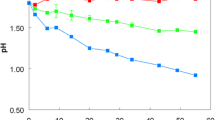Summary
Experiments with T. denitrificans have shown that this bacterium cannot develop in media devoid of ammonium salts, and that iron is required for growth. Pure cultures have been isolated by means of a modified medium which permits rapid growth in serial transfers. The organism has been characterized as an obligatory chemoautotroph which can oxidize a number of inorganic sulfur compounds (elementary sulfur, thiosulfate, tetrathionate) either aerobically with O2, or anaerobically with nitrate as oxidant.
Nitrite was found to be highly toxic to the nitrate-reducing enzyme system; concentrations as low as 3.5 · 10-4 m inhibit denitrification in the presence of sulfur about 40%. In the presence of thiosulfate, nitrite is rapidly decomposed to NO; this gas can subsequently be used as an oxidant, and is reduced to N2. The formation of NO depends on the presence of both thiosulfate and nitrite.
With resting cell suspensions CO2 assimilation has been established; the assimilation products are not merely carboxylation products, as demonstrated in experiments with C14O2.
Similar content being viewed by others
References
Allen, M. B., and C. B. van Niel: Experiments on bacterial denitrification. J. Bacter. 64, 397 (1952).
Baalsrud, K., and K. S. Baalsrud: The role of phosphate in CO2 assimilation of thiobacilli. In: Phosphorus Metabolism, II, 544. Baltimore: The Johns Hopkins Press 1952.
Beijerinck, M. W.: Phénomènes de réduction produits par les microbes. Arch. Néerland. Sci. Exactes et Naturelles, Série 2, 9, 131 (1904); Über das Nitratferment und über physiologische Artbildung. Folia Microbiologica, Delft 3, 91 (1914); Chemosynthesis at denitrification with sulfur as source of energy. Proc. Sec. Sci., Amsterdam: Koninkl. Akad. Wetensch. 22, 899 (1920).
Calvin, M., J. A. Bassham, A. A. Benson, V. H. Lynch, C. Quellet, L. Schou, W. Stepka, and N. E. Tolbert: Carbon dioxide assimilation in plants. In: Carbon dioxide fixation and photosynthesis. Symp. Soc. Exper. Biol. 5. New York: Acad. Press, Inc. 1951.
Gehring, A.: Beiträge zur Kenntnis der Physiologie und Verbreitung denitrifizirender Thiosulfat-Bakterien. Zbl. Bakter., Abt. 2, 42, 402 (1915).
Gmelins Handbuch der anorganischen Chemie. 8. Aufl., System Nr. 4, Liefer. 3. 1936.
Kingma Boltjes, T. Y.: Nitrifying bacteria. Arch. Mikrobiol. 6, 79 (1935).
Lieske, R.: Untersuchungen über die Physiologie denitrifizierender Schwefelbakterien. Sitzgsber. Heidelberg. Akad. Wiss. Math.-naturwiss. Kl., B. 6. (1912a);
Untersuchungen über die Physiologie denitrifizierender Schwefelbakterien. Ber. dtsch. bot. Ges. 30, 12 (1912b).
Nathansohn, A.: Über eine neue Gruppe von Schwefelbakterien und ihren Stoffwechsel. Mitt. zool. Sta. Neapel 15, 655 (1902).
Rusakova, G. S., and V. S. Butkevich: Denitrification by bacteria without the use of nitrates as nitrogen source. Microbiologija (U.S.S.R.) 10, 137 (1941).
Sato, R., and F. Egami: Studies on nitrate reductase, III. Bull. Chem. Soc. Japan 22, 137 (1949).
Sato, R., and M. Niwa: Studies on nitrate reductase, VII. Reinvestigation on the identity of the enzyme with cytochrome b. Bull. Chem. Soc. Japan 25, 202 (1952).
Schatz, A.: Uptake of carbon dioxide, hydrogen and oxygen by Hydrogenomonas facilis. J. Gen. Microbiol. 6, 329 (1952).
Sljderius, R.: Heterotrophe bacterien, die thiosulfaat oxydeeren. Diss. Amsterdam (1946).
Starkey, R. L.: Cultivation of organisms concerned in the oxidation of thiosulfate. J. Bacter. 28, 365 (1934); Products of the oxidation of thiosulfate by bacteria in mineral media. J. Gen. Physiol. 18, 325 (1935a); Isolation of some bacteria which oxidize thiosulfate. Soil Sci. 39, 197 (1935b).
Tiulpanova-Mosevich, M. V.: Denitrifikation auf dem anorganischen Nährboden. Arkh. Biol. Nauk. 30, 203 (1930).
Verhoeven, W.: Aerobic sporeforming nitrate reducing bacteria. Delft: Waltman 1952.
Vishniac, W.: On the metabolism of the chemolithoautotrophic bacterium Thiobacillus thioparus Beijerinck. Ph. D. Thesis, Stanford University 1949; The metabolism of Thiobacillus thioparus. I. The oxidation of thiosulfate. J. Bacter. 64, 363 (1952).
Winogradsky, S.: Microbiologie du sol; Problèmes et méthodes. Oeuvres complètes. Paris: Masson et Cie. 1949.
Author information
Authors and Affiliations
Rights and permissions
About this article
Cite this article
Baalsrud, K., Baalsrud, K.S. Studies on thiobacillus denitrificans. Archiv für Mikrobiologie 20, 34–62 (1954). https://doi.org/10.1007/BF00412265
Received:
Issue Date:
DOI: https://doi.org/10.1007/BF00412265




